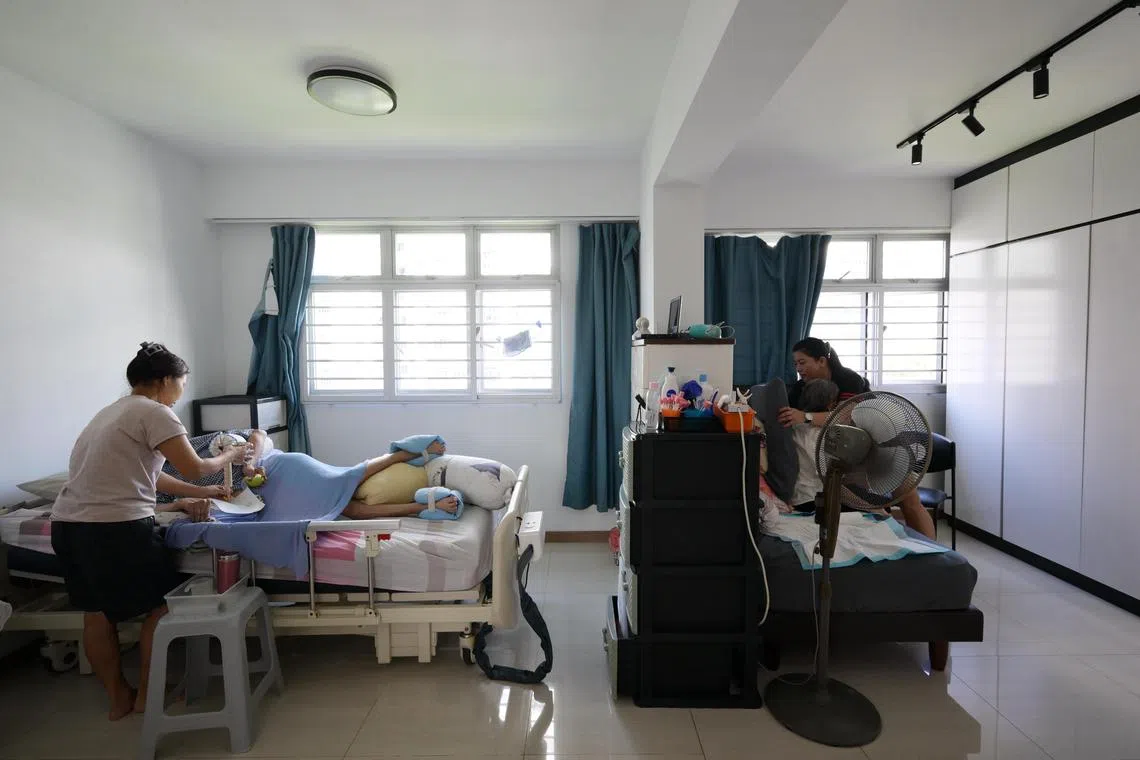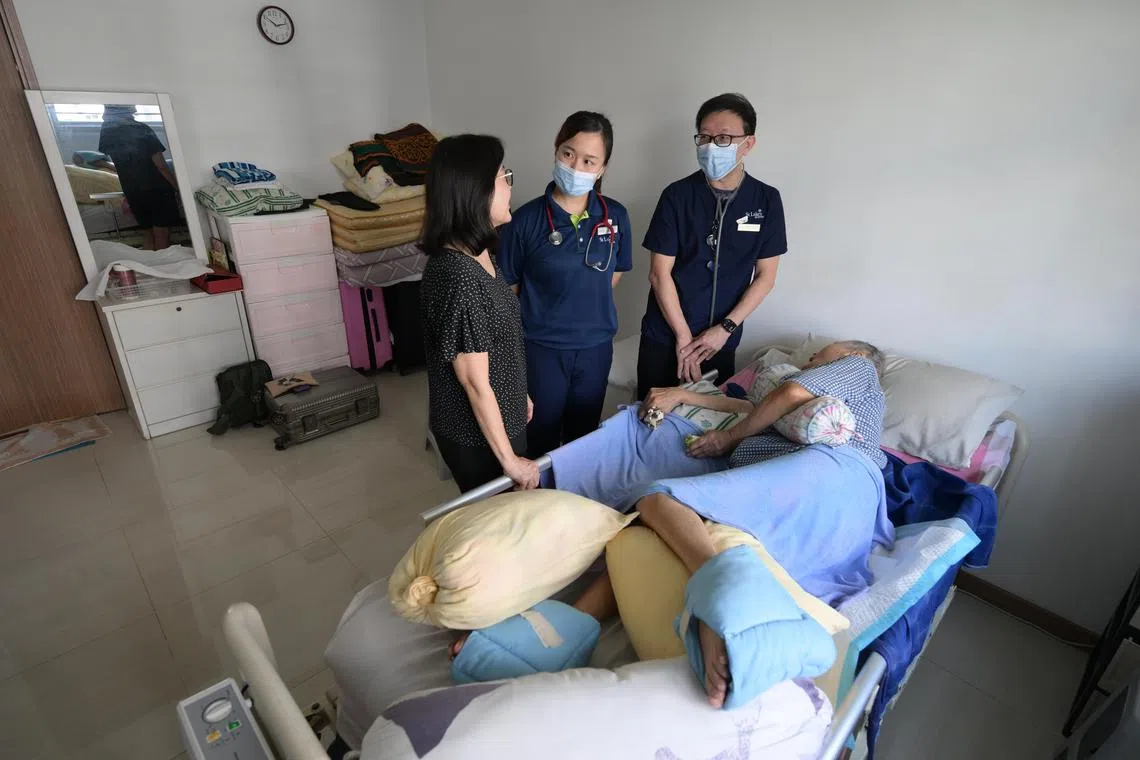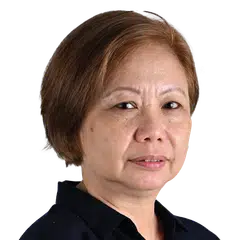St Luke’s Hospital puts ‘community’ back into healthcare in Singapore
Sign up now: Get ST's newsletters delivered to your inbox

Elderly residents being tended to by their caregivers at home.
ST PHOTO: NG SOR LUAN
Follow topic:
- St Luke's Hospital integrated healthcare into the community, helping seniors age at home and in the community with comprehensive support.
- St Luke Hospital's ecosystem where senior age in place was what PM Lawrence Wong plans for precincts with a higher concentration of seniors.
- Home-based services address complex patient needs, ensuring stable care and communication.
AI generated
SINGAPORE – Mr Nar Swee Kim and his wife Lee Lan came from Malaysia to Singapore in 2011 to be with two of their six children.
Mr Nar, now 91, and Madam Lee, 86, have both been bed-bound for the past three years. He suffered multiple strokes and has dementia, while she is battling developed peripheral artery disease, a condition in which narrowed arteries reduce blood flow to the legs.
Their care is managed by two foreign domestic helpers at their flat in Bukit Batok, with additional support from a home nursing service provided by St Luke’s Hospital, which visits every two months.
Another person who has benefited from the hospital’s services is Ms Priscilla Yeo, 68, who retired after working at Changi Airport for 30 years and hoped for a fresh start in life after retirement.
However, she was hit by recurring health issues, making frequent trips to hospital inevitable and resulting in her feeling down.
But since joining St Luke’s Hospital’s Western Silvercare programme – a community initiative which promotes health screening, preventive health measures and active ageing for seniors living in Bukit Batok – she has regained her strength, energy and self-confidence.
Associate Professor Tan Boon Yeow, chief executive of St Luke’s Hospital, told The Straits Times that the hospital, which was established in 1996, has been working for decades “to put ‘community’ back into healthcare”.
“It was and still is a ground-up effort,” he said.

Mr Nar Swee Kim has been bedbound for the past three years.
ST PHOTO: NG SOR LUAN
The hospital works with community partners like social service agencies Fei Yue, Renci, and New Hope Community Services; the Agency for Integrated Care and the different healthcare clusters to provide comprehensive care, enabling more seniors to age comfortably at home and within their communities.
This was what Prime Minister Lawrence Wong had planned for Toa Payoh, one of Singapore’s oldest towns, and “one or two other places” with a higher concentration of seniors.
In his National Day Rally speech on Aug 17, PM Wong said Singapore will be rolling out Age Well Neighbourhoods
“Many seniors choose to live independently, in order not to burden their children. We have been studying how to better support seniors in Toa Payoh and other older towns,” he said during his Rally speech.
He also said the Government will make “physical touchpoints more accessible to seniors” to enhance convenience, something St Luke’s Hospital had been working towards since 1999 with the establishment of St Luke’s ElderCare.

Ms Priscilla Yeo (left) said that since joining St Luke’s Hospital’s Western Silvercare programme, she has regained her strength, energy and self-confidence.
ST PHOTO: NG SOR LUAN
Prof Tan said St Luke’s Hospital has created its own ecosystem of care with home-based services, home nursing and community programmes to empower those in the community to age actively.
It is also working with another healthcare provider in furnishing community healthcare services to Harmony Village @ Bukit Batok, the first Community Care Apartments in Singapore.
Drawing insights from the Grant Study – the world’s longest study, conducted by Harvard Medical School and Massachusetts General Hospital since 1938 – Prof Tan said individuals who were the happiest, stayed the healthiest as they grew old, and lived the longest were those who had the warmest connections with others.
“That was what our Western Silvercare, launched in 2019, was designed to be. Apart from a personalised intervention plan developed for each senior with the goal of supporting their physical, mental and social well-being, we designed the WOW (Working Out to Wellness) programme – exercise sessions led by fitness coaches to focus on enhancing strength, endurance and balance,” he said.
The WOW programme played a significant role in helping Ms Yeo overcome her depression and loneliness. She discovered its activities while attending an active ageing centre as part of the Western Silvercare programme.
She now participates in the sports activities at Ren Ci Active Ageing Centre (Care), and even leads cooking classes every Monday.
Embracing ageing, ageing in place
Prof Tan said St Luke’s Hospital’s home nursing service, which started in 2012, has become an integral part of its holistic approach to providing eldercare and ensuring continuity of care for patients in and outside the hospital.
“Home nursing is a part of our home-based services to provide care for patients living mainly in Bukit Batok. Other types of services include home medical and home therapy services. They are managed by a dedicated team who provide complete care, and they improve the health and well-being of our patients,” he said.

Foreign domestic helpers Satur Nina Sarmiento (left) and Eh Shee Than are the main caregivers of Mr Nar Swee Kim and his wife, Madam Lee Lan.
ST PHOTO: NG SOR LUAN
According to Prof Tan, three groups of patients need home care services: those who are not able to visit a hospital, those who choose not to go to hospital, and those dealing with invisible health issues.
“Often, these patients have complex care needs such as multiple medical conditions, functional issues and social issues,” he said.
Using the example of a patient who repeatedly experienced falls, Prof Tan said it took a visit to the patient’s flat to reveal the cause – a leaky pipe under the kitchen sink – and resolve the issue. After the pipe was fixed, he stopped falling.
Home care staff nurse Katie Tan, 32, who joined St Luke’s Hospital in 2021, often helps bridge communication gaps between patients, caregivers and the care teams.
“With one care team communicating regularly with the patient’s caregiver and family, it helps in easily identifying care gaps and challenges faced by the patient and family members as this is crucial in medical care,” she told ST.
“The population is rapidly ageing and many seniors want to age where they live.”
Ms Tan, along with either Prof Tan or another doctor from the team, visits the Nars once every two months to ensure that things remain stable for them and to help optimise the care provided at home by foreign domestic helpers Satur Nina Sarmiento, 44, and Eh Shee Than, 39.
The Nars’ daughter Lay Choo, 57, a part-time teacher, said she relocated her parents from Malaysia to Singapore to provide better care for them.
“My siblings are all married and have moved abroad. My elder sister and elder brother are in Canada, a sister lives in the capital KL (Kuala Lumpur), another sister in Sabah. Both my youngest brother and I are in Singapore with our families, so it made sense to move mum and dad here,” Ms Nar said.
Since moving to Singapore, Mr Nar has had multiple strokes and cannot leave his bed.
“They used to live in Woodlands and we would call for transport to take him to St Luke’s for his rehabilitation, but he got motion sickness travelling the long distance,” Ms Nar said.
“Since the second stroke, he developed aphasia, and he lost his ability to walk. Getting a wheelchair-friendly service van to take him around was not only difficult but also expensive, so we moved them to Bukit Batok to be nearer to the hospital.
“With Katie and the doctors only a stone’s throw away, we can rest assured that my parents, though frail, will be well taken care of, especially when emergencies arise.”
Correction note: The names of the social service agencies Fei Yue, Renci, and New Hope Community Services have been updated in this version of the story.


